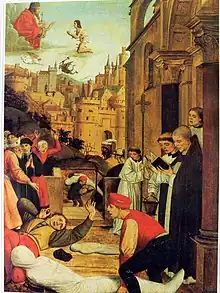Plague of Justinian
| Plague of Justinian | |
|---|---|
 Saint Sebastian pleads with Jesus for the life of a gravedigger afflicted by plague during the plague of Justinian. (Josse Lieferinxe, c. 1497–1499) | |
| Disease | Plague (Bubonic plague) |
| Location | Mediterranean Basin, Europe, Near East |
| Date | 541–549 AD |
The plague of Justinian or Justinianic plague (541–549 AD) was the first recorded major outbreak of the first plague pandemic: the first Old World pandemic of plague, the contagious disease caused by the bacterium Yersinia pestis. The disease afflicted the entire Mediterranean Basin, Europe, and the Near East, severely affecting the Sasanian Empire and the Byzantine Empire and especially Constantinople.[1][2][3] The plague is named for the Byzantine Emperor Justinian I (r. 527–565) who according to his court historian Procopius contracted the disease and recovered in 542, at the height of the epidemic which killed about a fifth of the population in the imperial capital.[1][2] The contagion arrived in Roman Egypt in 541, spread around the Mediterranean Sea until 544, and persisted in Northern Europe and the Arabian Peninsula until 549.[1] This first episode of the first plague pandemic had profound economic, social, and political effects across Europe and the Near East.[4]
In 2013, researchers confirmed earlier speculation that the cause of the plague of Justinian was Yersinia pestis, the same bacterium responsible for the Black Death (1346-1353).[5][6] Ancient and modern Yersinia pestis strains closely related to the ancestor of the Justinian plague strain have been found in the Tian Shan, a system of mountain ranges on the borders of Kyrgyzstan, Kazakhstan, and China, suggesting that the Justinian plague originated in or near that region.[7][8]
History


.jpg.webp)
The Byzantine historian Procopius first reported the epidemic in 541 from the port of Pelusium, near Suez in Egypt.[9] Two other first hand reports of the plague's ravages were by the Syriac church historian John of Ephesus[10] and Evagrius Scholasticus, who was a child in Antioch at the time and later became a church historian. Evagrius was afflicted with the buboes associated with the disease but survived. During the disease's four returns in his lifetime, he lost his wife, a daughter and her child, other children, most of his servants and people from his country estate.[11]
According to contemporary sources, the outbreak in Constantinople was thought to have been carried to the city by infected rats on grain ships arriving from Egypt.[9][12] To feed its citizens, the city and outlying communities imported large amounts of grain, mostly from Egypt. The rat population in Egypt thrived on feeding from the large granaries maintained by the government, and the fleas thrived as well.
Procopius,[13] in a passage closely modelled on Thucydides, recorded that at its peak the plague was killing 10,000 people in Constantinople daily, but the accuracy of the figure is in question, and the true number will probably never be known. He noted that because there was no room to bury the dead, bodies were left stacked in the open. Funeral rites were often left unattended to, and the entire city smelled like the dead.[14] In his Secret History, he records the devastation in the countryside and reports the ruthless response by the hard-pressed Justinian:
When pestilence swept through the whole known world and notably the Roman Empire, wiping out most of the farming community and of necessity leaving a trail of desolation in its wake, Justinian showed no mercy towards the ruined freeholders. Even then, he did not refrain from demanding the annual tax, not only the amount at which he assessed each individual, but also the amount for which his deceased neighbors were liable.[15]
As a result of the plague in the countryside, farmers could not take care of crops and the price of grain rose in Constantinople. Justinian had expended huge amounts of money for wars against the Vandals in the region of Carthage and the Ostrogoths' kingdom in Italy. He had invested heavily in the construction of great churches, such as Hagia Sophia. As the empire tried to fund the projects, the plague caused tax revenues to decline through the massive number of deaths and the disruption of agriculture and trade. Justinian swiftly enacted new legislation to deal more efficiently with the glut of inheritance suits being brought as a result of victims dying intestate.[16]
The plague's long-term effects on European and Christian history were enormous. As the disease spread to port cities around the Mediterranean, the struggling Goths were reinvigorated and their conflict with Constantinople entered a new phase. The plague weakened the Byzantine Empire at a critical point, when Justinian's armies had nearly retaken all of Italy and the western Mediterranean coast; the evolving conquest would have reunited the core of the Western Roman Empire with the Eastern Roman Empire. Although the conquest occurred in 554, the reunification did not last long. In 568, the Lombards invaded Northern Italy, defeated the small Byzantine army that had been left behind and established the Kingdom of the Lombards.[9][17] Gaul is known to have suffered severely; by virtue of its proximity it is unlikely that Britain escaped, although historical records of 6th century Britain are extremely poor, so there are no unequivocal attestations of the plague reaching the islands.[18]
Onset of the first plague pandemic
The Plague of Justinian is the first and the best known outbreak of the first plague pandemic, which continued to recur until the middle of the 8th century.[1][19] Some historians believe the first plague pandemic was one of the deadliest pandemics in history, resulting in the deaths of an estimated 15–100 million people during two centuries of recurrence, a death toll equivalent to 25–60% of Europe's population at the time of the first outbreak.[20][21][22][23] Research published in 2019 argued that the two-hundred-year-long pandemic's death toll and social effects have been exaggerated, comparing it to the modern third plague pandemic (1855–1960s).[24][25]
Epidemiology

Genetics of the Justinian plague strain
The Plague of Justinian is generally regarded as the first historically recorded epidemic of Yersinia pestis.[26][27] This conclusion is based on historical descriptions of the clinical manifestations of the disease[28] and the detection of Y. pestis DNA from human remains at ancient grave sites dated to that period.[29][30]
Genetic studies of modern and ancient Yersinia pestis DNA suggest that the origin of the Justinian plague was in Central Asia. The most basal or root level existing strains of the Yersinia pestis as a whole species are found in Qinghai, China.[31] Other scholars contest that, rather than Central Asia, the specific strain that composed the Justinian plague began in Subsaharan-Africa, and that the plague was spread to the Mediterranean by merchants from the Kingdom of Aksum in East Africa. This point of origin aligns more with the general South-North spread of the disease from Egypt into the rest of the Mediterranean world. It also explains why Sassanid Persia saw a later development of the outbreak despite stronger trade links with Central Asia.[32][33][34][35] After samples of DNA from Yersinia pestis were isolated from skeletons of Justinian plague victims in Germany,[36] it was found that modern strains currently found in the Tian Shan mountain range system are most basal known in comparison with the Justinian plague strain.[7] Additionally, a skeleton found in Tian Shan dating to around 180 AD and identified as an "early Hun" was found to contain DNA from Yersinia pestis closely related to the Tian Shan strain basal ancestor of the Justinian plague strain German samples.[8] This finding suggests that the expansion of nomadic peoples who moved across the Eurasian steppe, such as the Xiongnu and the later Huns, had a role in spreading plague to West Eurasia from an origin in Central Asia.[8]
Earlier samples of Yersinia pestis DNA have been found in skeletons dating from 3000 to 800 BC, across West and East Eurasia.[37] The strain of Yersinia pestis responsible for the Black Death, the devastating pandemic of bubonic plague, does not appear to be a direct descendant of the Justinian plague strain. However, the spread of Justinian plague may have caused the evolutionary radiation that gave rise to the currently extant 0ANT.1 clade of strains.[38][39]
Virulence and mortality rate
The number of deaths is uncertain. Some modern scholars believe that the plague killed up to 5,000 people per day in Constantinople at the peak of the pandemic.[25] According to one view, the initial plague ultimately killed perhaps 40% of the city's inhabitants and caused the deaths of up to a quarter of the human population of the Eastern Mediterranean.[40] Frequent subsequent waves of the plague continued to strike throughout the 6th, 7th and 8th centuries, with the disease becoming more localized and less virulent.
A revisionist view expressed by scholars such as Lee Mordechai and Merle Eisenberg argues that the mortality of the Justinian Plague was far lower than previously believed. They say that the plague might have caused high mortality in specific places, but it did not cause widespread demographic decline or decimate Mediterranean populations. According to them, any direct mid-to-long term effects of plague were minor.[25] However, their position has been the subject of a concerted critique by Peter Sarris. Sarris challenged both their core methodology and their handling of the sources. Sarris also provides up-to-date discussion of the genetic evidence, including the suggestion that the plague may have entered Western Eurasia via more than one route, with it possibly having struck England before Constantinople (based on the important discovery of plague victims at an early Anglo-Saxon burial site at Edix Hill near Cambridge).[41]
See also
- List of epidemics
- Medieval demography
- Plague of Amwas
- The volcanic winter of 536
Notes
- 1 2 3 4 Stathakopoulos, Dionysios (2018), "Plague, Justinianic (Early Medieval Pandemic)", The Oxford Dictionary of Late Antiquity, Oxford University Press, doi:10.1093/acref/9780198662778.001.0001, ISBN 978-0-19-866277-8, archived from the original on 2021-01-21, retrieved 2020-05-16
- 1 2 Arrizabalaga, Jon (2010), Bjork, Robert E. (ed.), "plague and epidemics", The Oxford Dictionary of the Middle Ages, Oxford University Press, doi:10.1093/acref/9780198662624.001.0001, ISBN 978-0-19-866262-4, archived from the original on 2014-10-21, retrieved 2020-05-16
- ↑ Floor, Willem (2018). Studies in the History of Medicine in Iran. Costa Mesa, California: Mazda Publishers. p. 3. ISBN 978-1933823942.
The Justinian plague (bubonic plague) also attacked the Sasanian lands.
- ↑ Gârdan, Gabriel-Viorel (2020). ""The Justinianic Plague": The Effects of a Pandemic in Late Antiquity and the Early Middle Ages". Romanian Journal of Artistic Creativity. 8 (4): 3–18. Archived from the original on 27 January 2023. Retrieved 26 January 2023.
- ↑ "Modern lab reaches across the ages to resolve plague DNA debate". phys.org. May 20, 2013. Archived from the original on July 27, 2019. Retrieved May 1, 2023.
- ↑ Maria Cheng (January 28, 2014). "Plague DNA found in ancient teeth shows medieval Black Death, 1,500-year pandemic caused by same disease". National Post. Archived from the original on March 23, 2015. Retrieved May 1, 2023.
- 1 2 Eroshenko, Galina A.; et al. (October 26, 2017). "Yersinia pestis strains of ancient phylogenetic branch 0.ANT are widely spread in the high-mountain plague foci of Kyrgyzstan". PLOS ONE. 12 (10): e0187230. Bibcode:2017PLoSO..1287230E. doi:10.1371/journal.pone.0187230. PMC 5658180. PMID 29073248.
- 1 2 3 Damgaard, Peter de B.; et al. (May 9, 2018). "137 ancient human genomes from across the Eurasian steppes". Nature. 557 (7705): 369–374. Bibcode:2018Natur.557..369D. doi:10.1038/s41586-018-0094-2. hdl:1887/3202709. PMID 29743675. S2CID 13670282.
- 1 2 3 Wade, Nicholas (October 31, 2010). "Europe's Plagues Came From China, Study Finds". The New York Times. New York City. Archived from the original on November 4, 2010. Retrieved November 1, 2010.
- ↑ John of Ephesus, Ecclesiastical History, part 2. Translation of relevant portions here Archived 2020-01-25 at the Wayback Machine.
- ↑ Evagrius, Historia Ecclesiae, IV.29.
- ↑ Eiland, Murray (2022). Interview with Johannes Preiser-Kapeller. "Networks of Rome, Byzantium, and China". Antiqvvs. 4 (1): 44. Archived from the original on 2023-04-25. Retrieved 2023-05-01.
- ↑ Procopius, Persian War II.22–23.
- ↑ Procopius: The Plague, 542
- ↑ Procopius, Anekdota, 23.20f.
- ↑ Justinian, Edict IX.3; J. Moorhead 1994; Averil Cameron, The Mediterranean World in Late Antiquity, AD 395–600, 1993:111.
- ↑ Rosen, William (2007). Justinian's Flea: Plague, Empire, and the Birth of Europe. New York City: Viking Adult. pp. 321–322. ISBN 978-0-670-03855-8. Archived from the original on 2010-01-25. Retrieved 2023-05-01.
- ↑ Charles-Edwards, Wales and the Britons, p. 216
- ↑ Eisenberg, Merle; Mordechai, Lee (2020). "The Justinianic Plague and Global Pandemics: The Making of the Plague Concept". The American Historical Review. 125 (5): 1632–1667. doi:10.1093/ahr/rhaa510. Archived from the original on 2023-07-01. Retrieved 2023-05-01.
- ↑ Mordechai, Lee; Eisenberg, Merle; Newfield, Timothy P.; Izdebski, Adam; Kay, Janet E.; Poinar, Hendrik (2019-12-17). "The Justinianic Plague: An inconsequential pandemic?". Proceedings of the National Academy of Sciences. 116 (51): 25546–25554. Bibcode:2019PNAS..11625546M. doi:10.1073/pnas.1903797116. ISSN 0027-8424. PMC 6926030. PMID 31792176.
- ↑ Maugh, Thomas. "An Empire's Epidemic". www.ph.ucla.edu. Archived from the original on 4 August 2002. Retrieved 20 March 2020.
- ↑ Rosen, William (2007). Justinian's Flea: Plague, Empire, and the Birth of Europe. New York City: Viking Adult. p. 3. ISBN 978-0-670-03855-8. Archived from the original on 2010-01-25. Retrieved 2023-05-01.
- ↑ "The Plague of Justinian". History Magazine. 11 (1): 9–12. 2009.
- ↑ Mordechai, Lee; Eisenberg, Merle; Newfield, Timothy P.; Izdebski, Adam; Kay, Janet E.; Poinar, Hendrik (November 27, 2019). "The Justinianic Plague: An inconsequential pandemic?". Proceedings of the National Academy of Sciences. 116 (51): 25546–25554. Bibcode:2019PNAS..11625546M. doi:10.1073/pnas.1903797116. ISSN 0027-8424. PMC 6926030. PMID 31792176.
- 1 2 3 Mordechai, Lee; Eisenberg, Merle (August 1, 2019). "Rejecting Catastrophe: The Case of the Justinianic Plague". Past & Present. Oxfordshire, England: Oxford University Press. 244 (1): 46. doi:10.1093/pastj/gtz009. ISSN 0031-2746.
- ↑ Russell, Josiah C. (1968). "That earlier plague". Demography. Ashburn, Virginia: Springer. 5: 174–184. doi:10.1007/bf03208570. S2CID 46979303.
- ↑ "Justinian's Plague (541-542 CE)". World History Encyclopedia. Archived from the original on 2021-04-18. Retrieved 2023-05-01.
- ↑ Procopius, History of the Wars, 7 Vols., trans. H. B. Dewing, Loeb Library of the Greek and Roman Classics, (Cambridge, Mass.: Harvard University Press, 1914), Vol. I, pp. 451–473.
- ↑ Wiechmann I, Grupe G. Detection of Yersinia pestis DNA in two early medieval skeletal finds from Aschheim (Upper Bavaria, 6th century A.D.)" Am J Phys Anthropol 2005 Jan;126(1) 48–55
- ↑ Harbeck, Michaela; Seifert, Lisa; Hänsch, Stephanie; Wagner, David M.; Birdsell, Dawn; Parise, Katy L.; Wiechmann, Ingrid; Grupe, Gisela; Thomas, Astrid; Keim, P; Zöller, L; Bramanti, B; Riehm, JM; Scholz, HC (2013). Besansky, Nora J (ed.). "Yersinia pestis DNA from Skeletal Remains from the 6th Century AD Reveals Insights into Justinianic Plague". PLOS Pathogens. 9 (5): e1003349. doi:10.1371/journal.ppat.1003349. PMC 3642051. PMID 23658525.
- ↑ Morelli, Giovanna; et al. (October 31, 2010). "Yersinia pestis genome sequencing identifies patterns of global phylogenetic diversity". Nature Genetics. 42 (12): 1140–1143. doi:10.1038/ng.705. PMC 2999892. PMID 21037571.
- ↑ Yohannes Gebre Selassie (2011), Plague as a Possible Factor for the Decline and Collapse of the Aksumite Empire: a New Interpretation, Northeast African Journal of Social Sciences
- ↑ Peter Sarris (2007), "Bubonic Plague in Byzantium: The Evidence of Non-Literary Sources", in Lester K. Little (ed.), Plague and the End of Antiquity: The Pandemic of 541–750, Cambridge University Press, pp. 119–132, at 121–123
- ↑ Michael McCormick (2007), "Toward a Molecular History of the Justinianic Pandemic", in Lester K. Little (ed.), Plague and the End of Antiquity: The Pandemic of 541–750, Cambridge University Press, pp. 290–312, at 303–304.
- ↑ Peter Sarris (2002), The Justinianic plague: origins and effects, Cambridge University Press
- ↑ Wagner, David M.; et al. (April 2014). "Yersinia pestis and the Plague of Justinian 541–543 AD: a genomic analysis". The Lancet. 14 (4): 319–326. doi:10.1016/S1473-3099(13)70323-2. PMID 24480148.
- ↑ Rasmussen, Simon; et al. (October 22, 2015). "Early Divergent Strains of Yersinia pestis in Eurasia 5,000 Years Ago". Cell. 163 (3): 571–582. doi:10.1016/j.cell.2015.10.009. PMC 4644222. PMID 26496604.
- ↑ McGrath, Matt (12 October 2011). "Black Death Genetic Code 'Built'". BBC World Service. Archived from the original on 1 January 2020. Retrieved 12 October 2011.
- ↑ Bos, Kirsten; Schuenemann, Verena J.; Golding, G. Brian; Burbano, Hernán A.; Waglechner, Nicholas; Coombes, Brian K.; McPhee, Joseph B.; Dewitte, Sharon N.; Meyer, Matthias; Schmedes, Sarah; Wood, James; Earn, David J. D.; Herring, D. Ann; Bauer, Peter; Poinar, Hendrik N.; Krause, Johannes (12 October 2011). "A draft genome of Yersinia pestis from victims of the Black Death". Nature. 478 (7370): 506–510. Bibcode:2011Natur.478..506B. doi:10.1038/nature10549. PMC 3690193. PMID 21993626.
- ↑ Cyril A. Mango, Byzantium: The Empire of New Rome (1980) emphasizes the demographic effects; Mark Whittow, "Ruling the late Roman and Byzantine city", Past and Present 33 (1990) argues against too great reliance on literary sources.
- ↑ Sarris, Peter (November 13, 2021). "Viewpoint New Approaches to the 'Plague of Justinian'". Past & Present. Oxford University Press. 254 (1): 315–346. doi:10.1093/pastj/gtab024.
Sources
- Charles-Edwards, T. M. (2013). Wales and the Britons 350–1064. Oxford, UK: Oxford University Press. ISBN 978-0-19-821731-2.
- Harbeck, M; Seifert, L; Hänsch, S; Wagner, DM; Birdsell, D; et al. (2013). "Yersinia pestis DNA from Skeletal Remains from the 6th Century AD Reveals Insights into Justinianic Plague". PLOS Pathog. 9 (5): e1003349. doi:10.1371/journal.ppat.1003349. PMC 3642051. PMID 23658525.
- Little, Lester K., ed. (2006). Plague and the End of Antiquity: The Pandemic of 541–750. Cambridge. ISBN 978-0-521-84639-4.
- Moorhead, J. (1994). Justinian. London.
- Mordechai, Lee, and Merle Eisenberg. 2019. "Rejecting Catastrophe: the case of the Justinianic Plague." Past & Present Archived 2019-07-22 at the Wayback Machine
- Mordechai, L; Eisenberg M; Newfield T; Izdebski A; Kay Janet; Poinar H. (2019). "The Justinianic Plague: An inconsequential pandemic?", PNAS https://doi.org/10.1073/pnas.1903797116 Archived 2023-07-01 at the Wayback Machine.
- Procopius. History of the Wars, Books I and II (The Persian War). Trans. H. B. Dewing. Vol. 1. Cambridge: Loeb-Harvard UP, 1954.—Chapters XXII and XXIII of Book II (pages 451–473) are Procopius's famous description of the Plague of Justinian. This includes the famous statistic of 10,000 people per day dying in Constantinople (page 465).
Further reading
- Drancourt, M; Roux, V; Dang, LV; Tran-Hung, L; Castex, D; Chenal-Francisque, V; et al. (2004). "Genotyping, Orientalis-like Yersinia pestis, and plague pandemics". Emerging Infectious Diseases. 10 (9): 1585–1592. doi:10.3201/eid1009.030933. PMC 3320270. PMID 15498160.
- Eisenberg, Merle, and Lee Mordechai. "The Justinianic Plague and Global Pandemics: The Making of the Plague Concept." American Historical Review 125.5 (2020): 1632–1667.
- McNeill, William H. (1976). Plagues and Peoples. New York: Bantam Doubleday Dell. ISBN 978-0-385-12122-4.
- Orent, Wendy (2004). Plague, The Mysterious Past and Terrifying Future of the World's Most Dangerous Disease. New York: Simon & Schuster. ISBN 978-0-7432-3685-0.
- Russell, J. C. (1958). "Late Ancient and Medieval Population". Transactions of the American Philosophical Society. New Series. 48 (3): 71–99. doi:10.2307/1005708. JSTOR 1005708.
- Sarris, Peter (13 November 2021). "New Approaches to the 'Plague of Justinian'". Past & Present. doi:10.1093/pastj/gtab024.